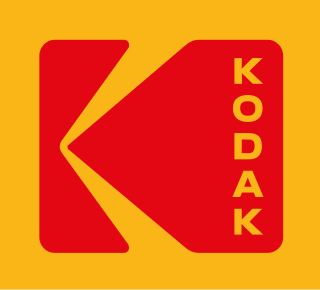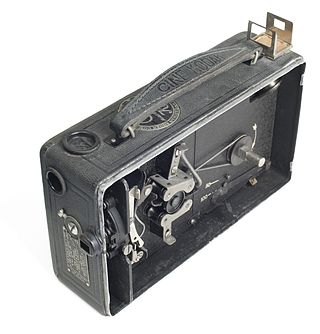
35 mm film is a film gauge used in filmmaking, and the film standard. In motion pictures that record on film, 35 mm is the most commonly used gauge. The name of the gauge is not a direct measurement, and refers to the nominal width of the 35 mm format photographic film, which consists of strips 1.377 ± 0.001 inches (34.976 ± 0.025 mm) wide. The standard image exposure length on 35 mm for movies is four perforations per frame along both edges, which results in 16 frames per foot of film.

The Eastman Kodak Company, referred to simply as Kodak, is an American public company that produces various products related to its historic basis in film photography. The company is headquartered in Rochester, New York, and is incorporated in New Jersey. It is best known for photographic film products, which it brought to a mass market for the first time.

110 is a cartridge-based film format used in still photography. It was introduced by Kodak in 1972. 110 is essentially a miniaturized version of Kodak's earlier 126 film format. Each frame is 13 mm × 17 mm, with one registration hole. Cartridges with 12, 20, or 24 frames are available on-line. Production variations sometimes have allowed for an additional image.

A slide projector is an opto-mechanical device for showing photographic slides.

An overhead projector, like a film or slide projector, uses light to project an enlarged image on a screen, allowing the view of a small document or picture to be shared with a large audience.

In photography, reversal film or slide film is a type of photographic film that produces a positive image on a transparent base. Instead of negatives and prints, reversal film is processed to produce transparencies or diapositives. Reversal film is produced in various sizes, from 35 mm to roll film to 8×10 inch sheet film.

Braun GmbH is a German consumer products company founded in 1921 and based in Kronberg im Taunus. The company is known for its design aesthetic from the 1960s through the 1980s, which included products such as electric shavers, radiograms and record players, movie cameras, slide projectors, clocks, and small kitchen appliances for which "Braun became shorthand for reliable, no-nonsense modernist goods."

Bell and Howell is a U.S.-based brand of cameras, lenses, and motion picture machinery. Originally founded as a company in 1907, headquartered in Wheeling, Illinois. Since 2010, the brand name has been licensed for a variety consumer electronics products.

Photo CD is a system designed by Kodak for digitizing and saving photos onto a CD. Launched in 1991, the discs were designed to hold nearly 100 high quality images, scanned prints and slides using special proprietary encoding. Photo CDs are defined in the Beige Book and conform to the CD-ROM XA and CD-i Bridge specifications as well. They were intended to play on CD-i players, Photo CD players, and any computer with a suitable software.
A film base is a transparent substrate which acts as a support medium for the photosensitive emulsion that lies atop it. Despite the numerous layers and coatings associated with the emulsion layer, the base generally accounts for the vast majority of the thickness of any given film stock. Since the late 19th century, there have been three major types of film base in use: nitrate, acetate, and polyester.

The Stereo Realist is a stereo camera that was manufactured by the David White Company from 1947 to 1971. It was the most popular 35 mm stereo camera ever manufactured and started the era of popular stereo photography of the mid 20th century.
Carl Braun Camera-Werk of Nuremberg, Germany, or Braun, as it was more commonly called, was founded as an optical production house. It is best known for its 35mm film cameras named Paxette, and for slide projectors named Paximat.

The Kodak Stereo Camera was a 35mm film stereo camera produced between 1954 and 1959. Similar to the Stereo Realist, the camera employed two lenses to take twin shots of scenes, which could then be viewed in dedicated image viewers. The lenses supported adjustable apertures and variable shutter speeds. The camera had a reputation for being easy to use, and sold approximately 100,000 units during the time it was produced.

The Kodak 35 Rangefinder is an improved version of the Kodak 35 that was launched by the Eastman Kodak Company in 1938 as their first 35mm camera manufactured in the USA. After some two years, the Company presented this improved Kodak 35 camera, with a new superstructure housing containing a viewfinder and a separate rangefinder, but without any addition to the identifying inscription on the body. It is generally referred to as the Kodak 35 Rangefinder model.

The Ciné-Kodak was the first 16mm camera, introduced in 1923 by the Eastman Kodak Company. It was intended to be used for home movie making.

A projector or image projector is an optical device that projects an image onto a surface, commonly a projection screen. Most projectors create an image by shining a light through a small transparent lens, but some newer types of projectors can project the image directly, by using lasers. A virtual retinal display, or retinal projector, is a projector that projects an image directly on the retina instead of using an external projection screen.

Multi-image is the now largely obsolete practice and business of using 35mm slides (diapositives) projected by single or multiple slide projectors onto one or more screens in synchronization with an audio voice-over or music track. Multi-image productions are also known as multi-image slide presentations, slide shows and diaporamas and are a specific form of multimedia or audio-visual production.
Carousel is a long-running multimedia comics slide show hosted by cartoonist Robert Sikoryak that has been presented in various venues in the United States and Canada since 1997. Sikoryak has described Carousel as "a cartoon variety show." Carousel has been presented at Dixon Place, MoCCA Fest, Parsons School of Design, The Brick Theater, and other venues.
Sawyer's, Inc. was an American manufacturer and retailer of slide projectors, scenic slides, View-Master reels and viewers, postcards, and related products, based in Portland, Oregon. Founded in 1914 as a photo-finishing company, Sawyer's began producing and selling View-Masters in 1939, and that soon became its primary product. It later diversified into other photographic products, mostly related to film transparencies, and established manufacturing plants in Europe, Japan and India. By the early 1960s, Sawyer's was the nation's second-largest manufacturer of slide projectors, and by 1965 slide projectors had surpassed View-Master reels and equipment as a percentage of the company's annual sales. In 1951, the company moved from Portland proper to the unincorporated Progress area in Portland's southwestern suburbs. In 1966, Sawyer's was acquired by New York-based General Aniline & Film (GAF), and its product lines and facilities were taken over by GAF. It was a subsidiary company of GAF until 1968, when it became simply a division of that company, renamed the GAF Consumer Photo Division. For several years thereafter, GAF used "Sawyer's" as a brand name for its slide projectors.

Hans Gugelot was an Indonesian-born, German engineer and industrial designer known for his modernist consumer products.

















